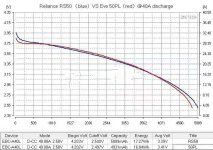View attachment 370931
What about this other new cell? Anybody hear of this one? I just order 5 samples to test.
The numbers looks impressive, charging capabilities and cycle life. We need to see if is true.
Reliance INR21700-RS50 Specifications
Summary
Cell Type: INR21700-RS50
Nominal Voltage: 3.6V
Nominal Capacity: 4950mAh (minimum)
Max Continuous Discharge: 70A (with 80°C temperature cutoff)
Max Continuous Charge: 15A
Standard Charge: 2.5A (0.5C) CCCV to 4.2V, 100mA cutoff
Fast Charge: 15A (3C) CCCV to 4.2V
Impedance (ACIR @1kHz): ≤4.0 mΩ
Discharge Cutoff Voltage: 2.5V
Charge Temperature Range: 0°C to 60°C
Discharge Temperature Range: -40°C to 80°C
Weight: ≤67g
Dimensions (Max): Ø 21.35mm x 70.30mm
Storage Temperature:
1 year: -20°C to 25°C
3 months: -20°C to 45°C
1 month: -20°C to 60°C
Cycle Life
Test Condition: 25°C, 8A charge / 40A discharge
Result: 400 cycles with ≥60% capacity retention
Test Condition: 25°C, 15A charge / 30A discharge
Result: 400 cycles with ≥60% capacity retention
Test Condition: 0°C, 8A charge / 10A discharge
Result: 200 cycles with ≥80% capacity retention
Test Condition: -10°C, 3A charge / 10A discharge
Result: 50 cycles with ≥80% capacity retention (Note: manufacturer does not guarantee performance/safety for charging below 0°C)
RS50 vs 50PL @ 40A. I honestly doubt it'll be able to beat the 50PL in terms of maximum CDR before heating up past 80C, or cycle life, but it might yield a little bit higher runtime at some current levels in the 15 - 35A range... I doubt it'll be able to compete with the P60B when it comes out though, not to mention the JP50 and the 50D. Very competitive market here!


